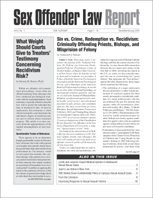Exploring Recent Developments in the Minnesota Sex Offender Program
Author: Leah Graf.; Eric Janus.
Source: Volume 12, Number 06, October/November 2011 , pp.81-85(5)

< previous article |next article > |return to table of contents
Abstract:
Has civil commitment fulfilled its goals of protecting society in a fair, effective, and efficient manner? Does civil commitment have a legitimate role to play in sex offender management policies, or should it be phased out in favor of more effective alternatives? What are the most significant challenges inherent in the implementation of sex offender management policies today? Based on the current state of knowledge and available technology (e.g., risk assessment, treatment) and on the range of possible alternative approaches, are sex offender civil commitment policies a viable and defensible strategy? In this era of fiscal retrenchment within the states, policymakers have been increasingly contemplating a similar array of questions, amidst incrementally growing populations, capacity constraints, and rising costs. This article discusses the experiences of Minnesota—one of a handful of states to expand its use of civil commitment in the early 1990s prior to the landmark ruling in Kansas v. Hendricks, and in many respects a bellwether for SOCC trends nationwide. We will be presenting SOCC experiences from other states in upcoming issues of SLR.Keywords:
Affiliations:
1: William Mitchell College of Law; 2: William Mitchell College of Law.